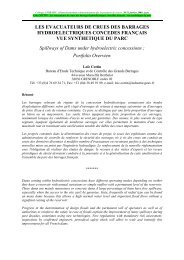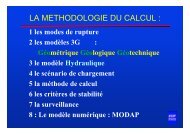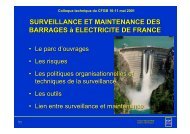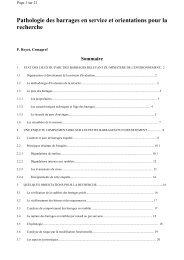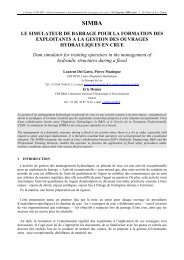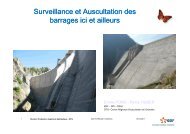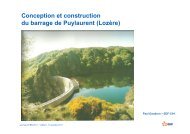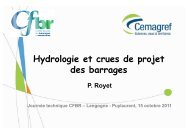Auscultation et surveillance de la mise en eau d'ouvrages ... - CFBR
Auscultation et surveillance de la mise en eau d'ouvrages ... - CFBR
Auscultation et surveillance de la mise en eau d'ouvrages ... - CFBR
- No tags were found...
Create successful ePaper yourself
Turn your PDF publications into a flip-book with our unique Google optimized e-Paper software.
Thème 1 – <strong>Auscultation</strong>, <strong>de</strong> <strong>la</strong> conception à <strong>la</strong> <strong>mise</strong> <strong>en</strong> <strong>eau</strong> – Organisation <strong>de</strong> <strong>la</strong> <strong>surveil<strong>la</strong>nce</strong> <strong>de</strong> <strong>la</strong> <strong>mise</strong> <strong>en</strong> <strong>eau</strong> d’ouvrages<br />
hydrauliques <strong>et</strong> utilisation innovante <strong>de</strong> fibres optiques<br />
1. ORGANISATION DE LA SURVEILLANCE PENDANT LA REMISE EN EAU DU<br />
CANAL DE CURBANS APRES D’IMPORTANTS TRAVAUX DE REHABILITATION<br />
1.1 Description générale <strong>de</strong> l’ouvrage<br />
Le canal <strong>de</strong> Curbans, construit <strong>en</strong>tre 1964 <strong>et</strong> 1965, se situe pour sa plus gran<strong>de</strong> partie dans le départem<strong>en</strong>t <strong>de</strong>s<br />
Hautes Alpes (05). Ce canal, <strong>de</strong> 5 200 m <strong>en</strong>viron <strong>de</strong> longueur, peut transiter 220 m 3 /s. Il est typique <strong>de</strong>s<br />
canaux <strong>de</strong> <strong>la</strong> Durance : <strong>la</strong>rgeur du p<strong>la</strong>t fond 9 m, p<strong>en</strong>te longitudinale 0,3 %, fruits <strong>de</strong>s talus intérieurs <strong>de</strong> 2/1<br />
<strong>et</strong> tirant d’<strong>eau</strong> normal <strong>de</strong> 8 à 10 m.<br />
Son revêtem<strong>en</strong>t étanche, qui était composé <strong>de</strong> 1 à 2 couches <strong>de</strong> béton bitumineux, a dû subir une réfection<br />
complète. Elle a consisté <strong>en</strong> <strong>la</strong> pose, sur le revêtem<strong>en</strong>t d’origine rénové, d’une couche <strong>de</strong> 10 cm <strong>de</strong> béton<br />
bitumineux drainant puis d’une couche <strong>de</strong> 8 cm <strong>de</strong> béton bitumineux étanche. Afin d’assurer une<br />
<strong>surveil<strong>la</strong>nce</strong> optimale du canal, son dispositif <strong>de</strong> drainage a été totalem<strong>en</strong>t rénové. Environ 10 km <strong>de</strong> drains<br />
ont été installés sous le radier <strong>et</strong> 9 exutoires (Figure 1) sous le canal ont été créés ou aménagés pour<br />
perm<strong>et</strong>tre <strong>la</strong> sortie <strong>de</strong>s <strong>eau</strong>x <strong>de</strong> drainage <strong>et</strong> leur mesure <strong>en</strong> 31 points différ<strong>en</strong>ts dans 9 exutoires.<br />
Figure 1 : Vue <strong>en</strong> p<strong>la</strong>n du canal (écoulem<strong>en</strong>t <strong>de</strong> <strong>la</strong> droite vers <strong>la</strong> gauche)<br />
Positionnem<strong>en</strong>t <strong>de</strong>s 9 exutoires <strong>de</strong>s débits <strong>de</strong> drainage dont chacun possè<strong>de</strong> un nom spécifique<br />
1.2 Préparation <strong>de</strong> <strong>la</strong> re<strong>mise</strong> <strong>en</strong> <strong>eau</strong><br />
La re<strong>mise</strong> <strong>en</strong> <strong>eau</strong> du canal <strong>de</strong> Curbans après une modification <strong>en</strong> profon<strong>de</strong>ur <strong>de</strong> son étanchéité était le point<br />
clef du proj<strong>et</strong> car elle <strong>de</strong>vait à <strong>la</strong> fois perm<strong>et</strong>tre <strong>de</strong> vérifier <strong>la</strong> qualité du travail effectué (qualité <strong>de</strong><br />
l’étanchéité) <strong>et</strong> perm<strong>et</strong>tre un r<strong>et</strong>our à l’exploitation normale <strong>de</strong> l’aménagem<strong>en</strong>t, après 10 ans <strong>de</strong> restriction<br />
sur <strong>la</strong> cote maximale d’exploitation, dans <strong>de</strong>s conditions <strong>de</strong> sûr<strong>et</strong>é optimales. Ainsi, <strong>la</strong> préparation <strong>de</strong> c<strong>et</strong>te<br />
re<strong>mise</strong> <strong>en</strong> <strong>eau</strong> a débuté 1 an avant sa date effective, basée sur <strong>de</strong>s protocoles spécifiques internes EDF qui<br />
associ<strong>en</strong>t étroitem<strong>en</strong>t l’exploitant <strong>et</strong> l’ingénierie.<br />
Elle a abouti à :<br />
- <strong>la</strong> <strong>mise</strong> <strong>en</strong> p<strong>la</strong>ce d’une organisation spécifique à l’intérieur même du proj<strong>et</strong> Curbans, par <strong>la</strong> nomination<br />
d’un Pilote Opérationnel Coordonateur <strong>de</strong>s Essais <strong>et</strong> d’un Chargé d’Essai dont les missions <strong>et</strong> les<br />
responsabilités étai<strong>en</strong>t c<strong>la</strong>irem<strong>en</strong>t définies dans un PGE (P<strong>la</strong>n Global d’Essais), docum<strong>en</strong>t d’organisation<br />
qui gouverna l’<strong>en</strong>semble du déroulem<strong>en</strong>t <strong>de</strong> <strong>la</strong> re<strong>mise</strong> <strong>en</strong> <strong>eau</strong>. A noter que le PGE a reçu formellem<strong>en</strong>t<br />
l’approbation <strong>de</strong> l’autorité <strong>de</strong> contrôle (DREAL PACA) pour pouvoir débuter <strong>la</strong> re<strong>mise</strong> <strong>en</strong> <strong>eau</strong> du canal ;<br />
- <strong>la</strong> <strong>mise</strong> au point du protocole <strong>de</strong> montée du p<strong>la</strong>n d’<strong>eau</strong> (gradi<strong>en</strong>ts <strong>et</strong> paliers) ainsi qu’à <strong>la</strong> définition <strong>de</strong> <strong>la</strong><br />
<strong>surveil<strong>la</strong>nce</strong> à réaliser <strong>et</strong> aux schémas décisionnels qui <strong>en</strong> résult<strong>en</strong>t pour tous les scénarii <strong>en</strong>visagés afin<br />
<strong>de</strong> garantir <strong>en</strong> perman<strong>en</strong>ce <strong>la</strong> maîtrise <strong>de</strong> <strong>la</strong> sûr<strong>et</strong>é <strong>de</strong> l’ouvrage. L’<strong>en</strong>semble <strong>de</strong> ces élém<strong>en</strong>ts techniques<br />
ont été consignés dans le cahier d’essais, docum<strong>en</strong>t <strong>de</strong> référ<strong>en</strong>ce utilisé tout au long du déroulem<strong>en</strong>t du<br />
processus.<br />
C<strong>et</strong>te re<strong>mise</strong> <strong>en</strong> <strong>eau</strong> était composée <strong>de</strong> <strong>de</strong>ux phases avec <strong>de</strong>ux buts bi<strong>en</strong> distincts :<br />
- <strong>la</strong> requalification intrinsèque du canal, qui correspond à sa capacité à cont<strong>en</strong>ir <strong>de</strong> l’<strong>eau</strong> <strong>en</strong> toute sûr<strong>et</strong>é,<br />
Page 2



